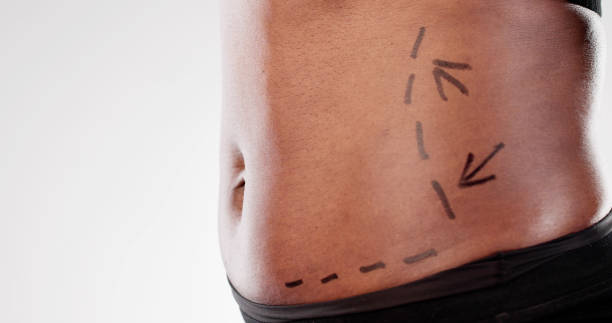- Fat Reduction: It targets stubborn fat deposits that are resistant to diet and exercise, such as those in the abdomen, thighs, arms, and back.
- Skin Tightening: After significant weight loss, the skin can become loose and saggy. Body contouring helps to remove excess skin and tighten the remaining skin for a firmer appearance.
- Body Sculpting: It allows for the shaping of specific body areas to achieve a more toned and defined look, enhancing the overall body silhouette.
- Post-Pregnancy: Many women opt for body contouring procedures to address changes in their bodies after pregnancy, such as loose abdominal skin or stretched breasts.
- Boosting Self-Confidence: By improving body shape and appearance, body contouring can increase self-esteem and confidence, helping individuals feel more comfortable in their bodies.
Common body contouring procedures include liposuction, tummy tucks, arm lifts, thigh lifts, and non-surgical methods like CoolSculpting or radiofrequency treatments.

What is the best type of body contouring?
The “best” type of body contouring depends on individual goals, body type, and the specific areas of the body that need treatment. Here’s a brief overview of the most common types of body contouring procedures, along with the scenarios in which they are most effective:
1. Liposuction
- Best for: Removing localized fat deposits in areas like the abdomen, thighs, arms, and back.
- How it works: A surgical procedure that suctions out fat from specific areas of the body.
- Pros: Effective for significant fat reduction and body sculpting; results are usually permanent with a stable weight.
- Cons: Surgical procedure with associated risks and recovery time.
2. Tummy Tuck (Abdominoplasty)
- Best for: Removing excess skin and tightening muscles in the abdominal area, especially after significant weight loss or pregnancy.
- How it works: A surgical procedure that removes excess skin and fat and tightens abdominal muscles.
- Pros: Provides a flatter, more toned abdomen; effective for loose skin and separated muscles.
- Cons: Invasive surgery with significant recovery time.
3. CoolSculpting (Cryolipolysis)
- Best for: Non-surgical fat reduction in localized areas such as the abdomen, flanks, and thighs.
- How it works: Fat cells are frozen and gradually eliminated by the body.
- Pros: Non-invasive, minimal downtime, gradual and natural-looking results.
- Cons: Less effective for large areas or significant fat reduction; results take a few months to become noticeable.
4. Radiofrequency (RF) Treatments
- Best for: Skin tightening and mild to moderate fat reduction.
- How it works: RF energy heats the deep layers of the skin, promoting collagen production and fat reduction.
- Pros: Non-invasive, no downtime, gradual improvement in skin texture and tone.
- Cons: Multiple sessions are often required; less effective for significant fat reduction.
5. Laser Lipolysis (e.g., SmartLipo)
- Best for: Targeted fat reduction with some skin tightening.
- How it works: Laser energy is used to liquefy fat cells, which are then removed or absorbed by the body.
- Pros: Minimally invasive, shorter recovery time compared to traditional liposuction, some skin tightening effects.
- Cons: Best for smaller areas; results can vary depending on the patient.
6. Body Lifts (e.g., Arm Lift, Thigh Lift)
- Best for: Removing excess skin and fat in specific areas, such as the arms, thighs, or buttocks.
- How it works: Surgical procedures that remove excess skin and fat from targeted areas.
- Pros: Effective for significant skin tightening and reshaping after major weight loss.
- Cons: Invasive surgery with a longer recovery period and potential scarring.
7. Ultrasound Cavitation
- Best for: Non-invasive fat reduction in small to moderate areas.
- How it works: Uses ultrasound waves to break down fat cells, which are then eliminated by the body.
- Pros: Non-invasive, no downtime, gradual fat reduction.
- Cons: Multiple sessions required; results are more subtle compared to surgical options.
Factors to Consider:
- Extent of Fat Reduction Needed: Surgical options like liposuction or tummy tucks are more effective for significant fat and skin removal, while non-surgical options are better for smaller areas.
- Skin Elasticity: If loose skin is a concern, procedures that include skin tightening (like tummy tucks or RF treatments) may be more suitable.
- Recovery Time: Non-surgical options offer quicker recovery but may require multiple sessions, while surgical options typically involve more downtime but often provide more dramatic results.
- Budget: Non-surgical options are generally less expensive but may need repeated treatments, while surgical
options can be more costly upfront but might achieve desired results in a single procedure.
Conclusion:
- For Significant Fat and Skin Reduction: Surgical options like liposuction and tummy tucks are generally the most effective.
- For Non-Invasive Fat Reduction: CoolSculpting and RF treatments are popular for those looking to avoid surgery with minimal downtime.
- For Skin Tightening: RF treatments and laser lipolysis offer non-invasive ways to tighten skin, though results may be less dramatic than surgery.
Ultimately, the best type of body contouring is one that aligns with your personal goals, health condition, and willingness to undergo surgery or multiple treatments. Consulting with a qualified plastic surgeon or dermatologist is essential to determine the most appropriate procedure for your needs.
